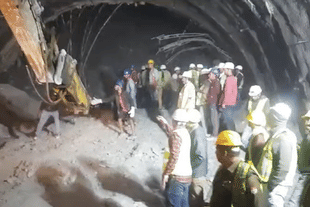News Brief
Uttarakhand Tunnel Collapse: Here's What We Know So Far About The Twin Strategies Being Used To Rescue 40 Trapped Men
Swarajya Staff
Nov 14, 2023, 01:17 PM | Updated 01:17 PM IST
Save & read from anywhere!
Bookmark stories for easy access on any device or the Swarajya app.


Relief and rescue efforts continued on Monday (13 November) in Uttarakhand's Uttarkashi district after a portion of an under-construction tunnel, set to connect Gangotri and Yamunotri routes, collapsed, entrapping 40 workers.
The trapped workers have access to oxygen cylinders, and extra oxygen is being supplied through a pipe initially meant for water. Food, including chana and puffed rice, is also being sent to them through this pipe, and they are equipped with torches.
A bigger pipe for oxygen supply was damaged in the collapse.
The State Disaster Response Force, National Disaster Response Force, local police, and administration are jointly conducting the rescue using JCBs and heavy excavators to clear the debris.
Shashi Chauhan, a mechanical foreman at Navayuga Engineering responsible for the tunnel's construction, reported that around 50-60 workers were returning from a night shift to celebrate Diwali when part of the tunnel collapsed at about 5.30 am, trapping those inside.
Initially, the trapped workers panicked due to lack of communication and unawareness of the situation. They had walkie-talkies, but they were ineffective due to the additional debris.
However, communication was later established using pipes around midnight, which helped to calm them.
They are in continuous contact with rescuers and are provided with necessities upon request.
The tunnel, a part of the all-weather Char Dham road project and stretching 4,531 meters, is being constructed by Navayuga Engineering under the NHIDCL's supervision.
It was slated for completion by next February.
As per NHIDCL, of the 4.5 km long tunnel, 2.34 km from the Silkyara side and 1.75 km from the Dandalgaon (Barkot) side were completed.
The collapse occurred during ongoing work, trapping workers beyond the 260-meter mark from the Silkyara side.
The debris removed by heavy excavator machines is being taken away by trucks. At least 21 metres of loose debris had been removed, though some gains were reversed as more debris fell and reduced the excavation to only 14 metres, Indian Express reported.
Ranjit Sinha, Secretary (Disaster Management), said that to deal with the falling debris, they are using shotcrete method, which has only been partially successful so far.
“The rock in the area is very loose, almost crumbly. Because of that, when we remove the debris, more debris falls. However, the rate of the debris falling is lower than the rate of debris being removed. We are using the shotcrete method, under which soon after debris is removed, concrete is thrown at the ceiling with high pressure to stop more debris from falling. We are getting partial success with this,” Sinha was quoted as saying in the IE report.
Another strategy being considered involves drilling through the debris and inserting a 900 mm steel pipe for evacuation of those trapped inside, with a specialised machine brought from Dehradun.
Sinha discussed the difficulty in predicting such collapses and the possibility of improved safety measures and alarm systems preventing such incidents.
A technical team and consultants are investigating, with a report expected to clarify the situation and determine if better safety protocols could have averted the entrapment.
NHIDCL and the contractors have been directed to inform the families of the trapped men that the situation is under control and they are safe in a bid to prevent unnecessary panic.
Further, Chief Minister Pushkar Singh Dhami also visited the site, reviewed the operations, and urged officials to expedite the rescue, emphasising it as a top government priority.




